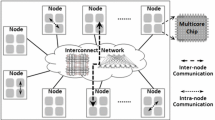Abstract
Many traditional parallel matrix computing algorithms are performed on regular resource topologies, such as mesh. However, the grid resource topology is often irregular in practice. In this paper, we present a transformation algorithm of grid resource topology for achieving virtual meshes. And on the virtual mesh, these traditional parallel algorithms can be performed in a modern computational grid environment. The basic idea of our topology transformation is to align the basic blocks of grid computational resources through permutations in a virtual mesh. Designing a cost function of heuristic search scheme for the transformation, we use it to fully exploit the computational and communicational abilities of grid resources. The experiment results show that our aligning block permutation can significantly reduce the time complexity of search tree. They also show that the heuristic search scheme can effectively find the block permutation that makes better use of computational and communicational abilities of grid resources.
Similar content being viewed by others
References
Ababneh I, Bani-Mohammad S, Ould-Khaoua M (2010) An adaptive job scheduling scheme for mesh-connected multicomputers. J Supercomput 53:5–25
Azgomi MA, Entezari-Maleki R (2010) Task scheduling modelling and reliability evaluation of grid services using coloured petri nets. Future Gener Comput Syst 26:1141–1150
Berman F, Fox G, Hey AJG (eds) (2003) Grid computing: making the global infrastructure a reality. Wiley, New York
Chen J, Taylor VE (2002) Mesh partitioning for efficient use of distributed systems. IEEE Trans Parallel Distrib Syst 13(1):67–79
Coffman EG, Garey MR, Johnson DS (1997) Approximation algorithms for bin packing: A survey. Approximation algorithms for NP-hard problems, pp 46–93
Cormen TH, Leiserson CE, Rivest RL, Stein C (2001) Introduction to algorithms, 2nd edn. MIT Press, Cambridge
Dongarra J, Foster I, Fox G, Gropp W, Kennedy K, Torczon L, White A (eds) (2003) Sourcebook of parallel computing. Morgan Kaufmann, San Mateo
Falzon G, Li M (2010) Enhancing list scheduling heuristics for dependent job scheduling in grid computing environments. J Supercomput 1–27
Foster I, Kesselman C (eds) (1998) The grid: blueprint for a new computing infrastructure, 1st edn. Morgan Kaufman, San Francisco
Garg SK, Buyya R, Siegel HJ (2010) Time and cost trade-off management for scheduling parallel applications on utility grids. Future Gener Comput Syst 26:1344–1355
Grama A, Gupta A, Karypis G, Kumar V (eds) (2003) Introduction to parallel computing, 2nd edn. Pearson Education, Upper Saddle River
Hogg RV, Tanis EA (1993) Probability and statistical inference, 4th edn. Macmillan & Co, London
Huang S, Aubanel E, Bhavsar VC (2006) PaGrid: a mesh partitioner for computational grids. J Grid Comput 4(1):71–88
Karniadakis GM, Kirby RM (2003) Parallel scientific computing in C++ and MPI. Cambridge University Press, Cambridge
Leung JYT, Tam TW, Wong CS (1990) Packing squares into a square. J Parallel Distrib Comput 10:271–275
Meyerhenke H, Monien B, Sauerwald T (2009) A new diffusion-based multilevel algorithm for computing graph partitions. J Parallel Distrib Comput 69:750–761
Modi JJ (1988) Parallel algorithms and matrix computation. Clarendon, Oxford
Parsa S, Entezari-Maleki R (2010) Task dispatching approach to reduce the number of waiting tasks in grid environments. J Supercomput 1–17
Pearl J (1984) Heuristics: intelligent search strategies for computer problem solving. Addison-Wesley/Longman, Reading/Boston
Pellegrini F, Roman J (2006) Scotch: A software package for static mapping by dual recursive bipartitioning of process and architecture graphs. In: Lecture notes in computer science, vol 1067, pp 493–498
Rama Mohan Rao A. (2009) Parallel mesh-partitioning algorithms for generating shape optimised partitions using evolutionary computing. Adv Eng Softw 40:141–157
Walshaw C, Cross M (2001) Multilevel mesh partitioning for heterogeneous communication networks. Future Gener Comput Syst 17(5):601–623
Author information
Authors and Affiliations
Corresponding authors
Rights and permissions
About this article
Cite this article
Chen, UR., Lin, W. Aligning block permutation methods for topology transformation on computational grids. J Supercomput 61, 545–559 (2012). https://doi.org/10.1007/s11227-011-0613-5
Published:
Issue Date:
DOI: https://doi.org/10.1007/s11227-011-0613-5




